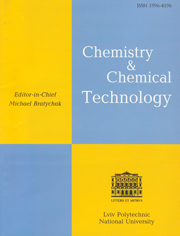Mass Transfer during Boric Acid Dissolution
| Attachment | Size |
|---|---|
| 432.21 KB |
[1] Chong, G.; Pueyo, J.; Demergasso C. The Borate Deposits in Chile. Revista Geológica de Chile 2000, 27, 99-119. http://www.andeangeology.cl/index.php/revista1/article/view/V27n1-a07
https://doi.org/10.4067/S0716-02082000000100007
[2] Symak, D.; Atamaniuk, V.; Gumnitsky, Ya. Analysis of Dissolution Kinetics Based on the Local Isotropic Turbulence Theory. Chem. Chem. Technol. 2015, 9, 493-497. https://doi.org/10.23939/chcht09.04.493
https://doi.org/10.23939/chcht09.04.493
[3] Sabadash, V.; Mylanyk, O.; Matsuska, O.; Gumnitsky, J. Kinetic Regularities of Copper Ions Adsorption by Natural Zeolite. Chem. Chem. Technol. 2017, 11, 459-462. https://doi.org/10.23939/chcht11.04.459
https://doi.org/10.23939/chcht11.04.459
[4] Frikha, N.; Hmercha, A.; Gabsi, S. Modelling of a Solid Dissolution in Liquid with Chemical Reaction: Application to the Attack Reaction of Phosphate by Sulphuric Acid. Can. J. Chem. Eng. 2014, 92, 1829-1838. https://doi.org/10.1002/cjce.21986
https://doi.org/10.1002/cjce.21986
[5] Mena, P.; Ferreira, A.; Teixeira, J.A.; Rocha, F. Effect of Some Solid Properties on Gas-Liquid Mass Transfer in a Bubble Column. Chem. Eng. Process.: Process Intensif. 2011, 50, 181-188. https://doi.org/10.1016/j.cep.2010.12.013
https://doi.org/10.1016/j.cep.2010.12.013
[6] Gumnitsky, Ya.M.; Symak, D.M.; Nagursky, O.A. Rozchynennia tverdykh til u tryfaznii systemi, utvorenii vakuumuvanniam. Scientific Works 2015, 47, 130-133. https://journals.ontu.edu.ua/index.php/swonaft/article/view/368
[7] Symak, D.M.; Luta, O.V. Nestatsionarnyi protses rozchynennia sharu zernystoho materialu. Khimiia, tekhnolohiia rechovyn ta yikh zastosuvannia 2015, 812, 308-312.
[8] Inglezakis, V.J.; Balsamo, M.; Montagnaro, F. Liquid−Solid Mass Transfer in Adsorption Systems an Overlooked Resistance? Ind. Eng. Chem. Res. 2020, 59, 22007−22016. https://doi.org/10.1021/acs.iecr.0c05032
https://doi.org/10.1021/acs.iecr.0c05032
[9] Tokura, V.Y.; Uddin Md.A.; Kato, Y. Effect of Suspension Pattern of Sedimentary Particles on Solid/Liquid Mass Transfer in a Mechanically Stirred. Ind. Eng. Chem. Res. 2019, 58, 10172−10178. https://doi.org/10.1021/acs.iecr.9b00594
https://doi.org/10.1021/acs.iecr.9b00594
[10] Crapse, K.; Kyser, E. Literature Review of Boric Acid Solubility Data. United States: N. p., 2011. https://doi.org/10.2172/1025802
https://doi.org/10.2172/1025802
[11] Carletti, C.; Bikić, S.; Montante, G.; Paglianti, A. Mass Transfer in Dilute Solid-Liquid Stirred Tanks. Ind. Eng. Chem. Res. 2018, 57, 6505-6515. https://doi.org/10.1021/acs.iecr.7b04730
https://doi.org/10.1021/acs.iecr.7b04730
[12] Joshi, S.S.; Dalvi, V.H.; Vitankar, V.S.; Joshi, A.J.; Joshi, J.B. Novel Correlation for the Solid-Liquid Mass Transfer Coefficient in Stirred Tanks Developed by Interpreting Machine Learning Models Trained on Literature Data. Ind. Eng. Chem. Res. 2023, 62, 19920-19935. https://doi.org/10.1021/acs.iecr.3c02442
https://doi.org/10.1021/acs.iecr.3c02442
[13] Atamaniuk, V.M.; Gumnitsky, Ya.M. Naukovi Osnovy Filtratsiinoho Sushinnia Dyspersnykh Materialiv; Lviv Polytechnic Publishing House: Lviv, 2013.
[14] Miyabe, K.; Isogai, R. Estimation of Molecular Diffusivity in Liquid Phase Systems by the Wilke-Chang Equation. J. Chromatogr. A 2011, 1218, 6639-6645. https://doi.org/10.1016/j.chroma.2011.07.018
https://doi.org/10.1016/j.chroma.2011.07.018










